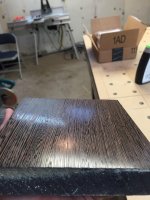Tayler_mann
Member
- Joined
- Nov 23, 2014
- Messages
- 416
So I just purchased a good majority of the accessories for polishing with the 150 Rotex. My plan is to do some practice on my own pieces to see how well a high polish holds up. So I have a few questions on the process before I shred a sheepskin pad or sponge.
I am building a picture frame out of wenge and would like to do a chamfer on the inside and a very slight round over on the outside, or possibly, another chamfer. Than of course I will rabbet in the 10mm pocket for the picture, glass, and backing to set in. So if I decide to do a polish for the base of sealing my wood I need to do all sides and groves equally. My question is how easy is it to keep nice hard corners and get inside groves and such with the interface pads and going through all the grits. Another option I had thought of was applying a natural oil over the entire frame and than a thin, very thin, layer of wax and than just polishing the face of the frame to keep it simple.
I appreciate any help on this topic or any advice as I am brand new to the polishing of wood world.
I am building a picture frame out of wenge and would like to do a chamfer on the inside and a very slight round over on the outside, or possibly, another chamfer. Than of course I will rabbet in the 10mm pocket for the picture, glass, and backing to set in. So if I decide to do a polish for the base of sealing my wood I need to do all sides and groves equally. My question is how easy is it to keep nice hard corners and get inside groves and such with the interface pads and going through all the grits. Another option I had thought of was applying a natural oil over the entire frame and than a thin, very thin, layer of wax and than just polishing the face of the frame to keep it simple.
I appreciate any help on this topic or any advice as I am brand new to the polishing of wood world.


